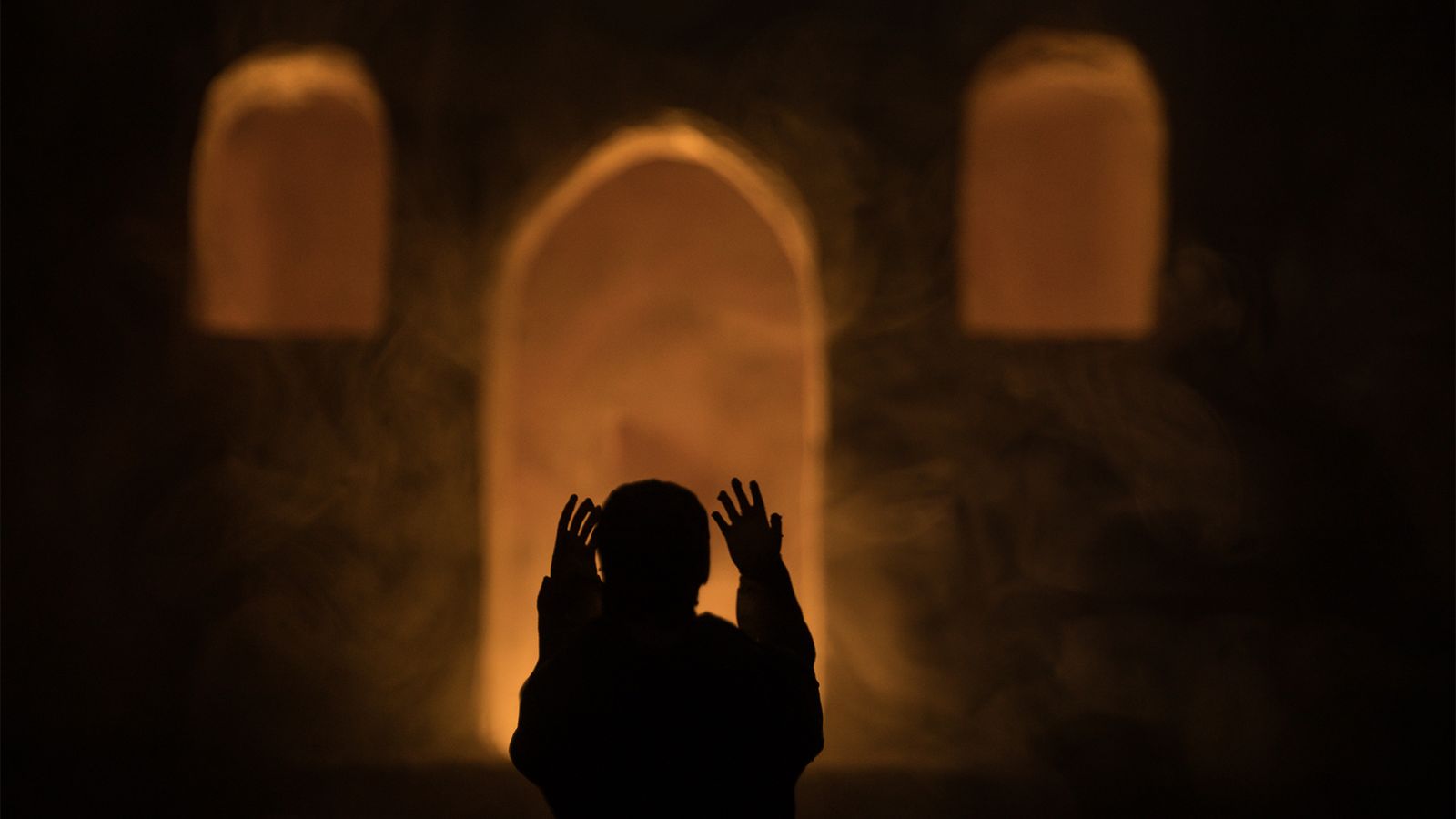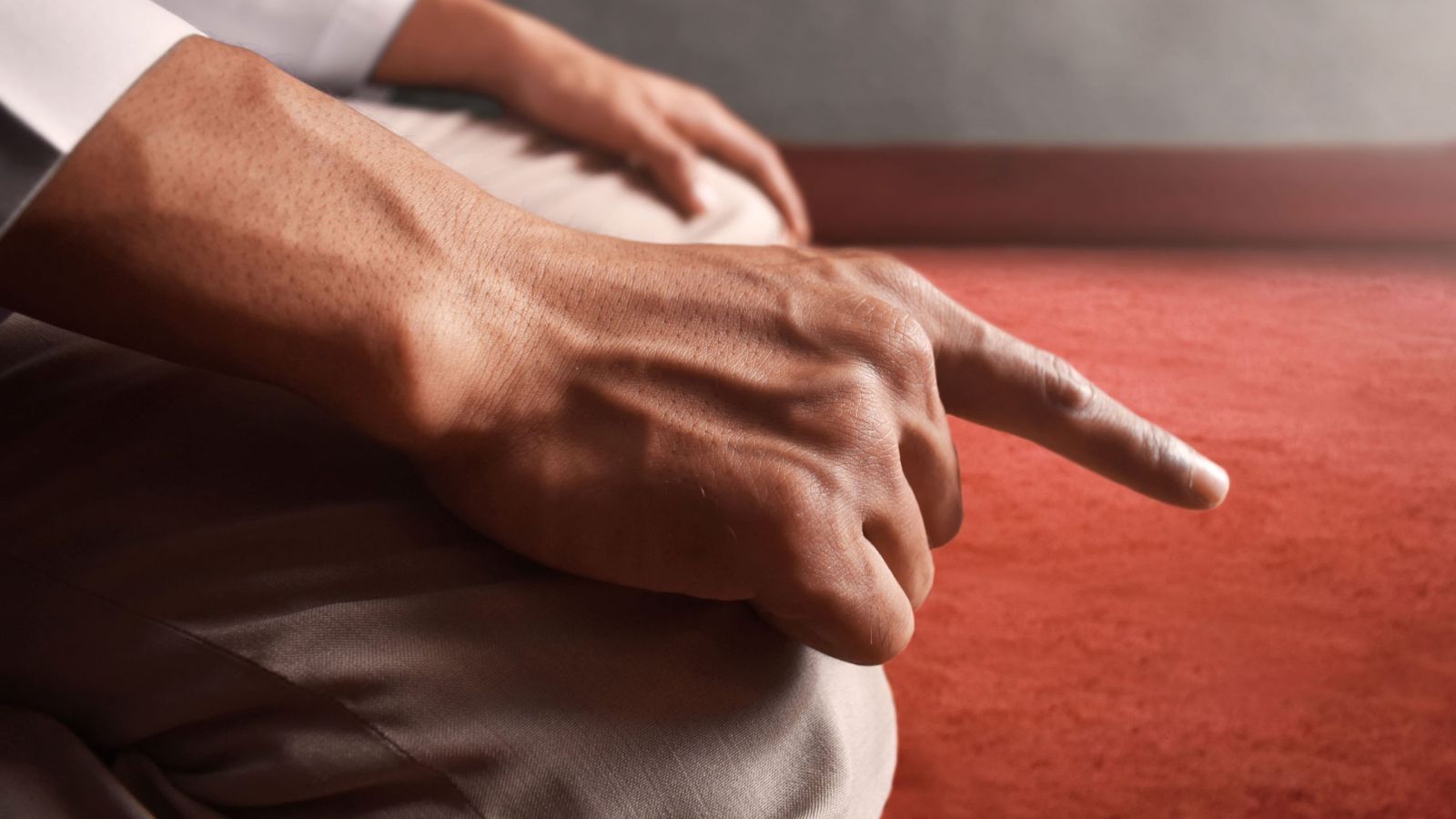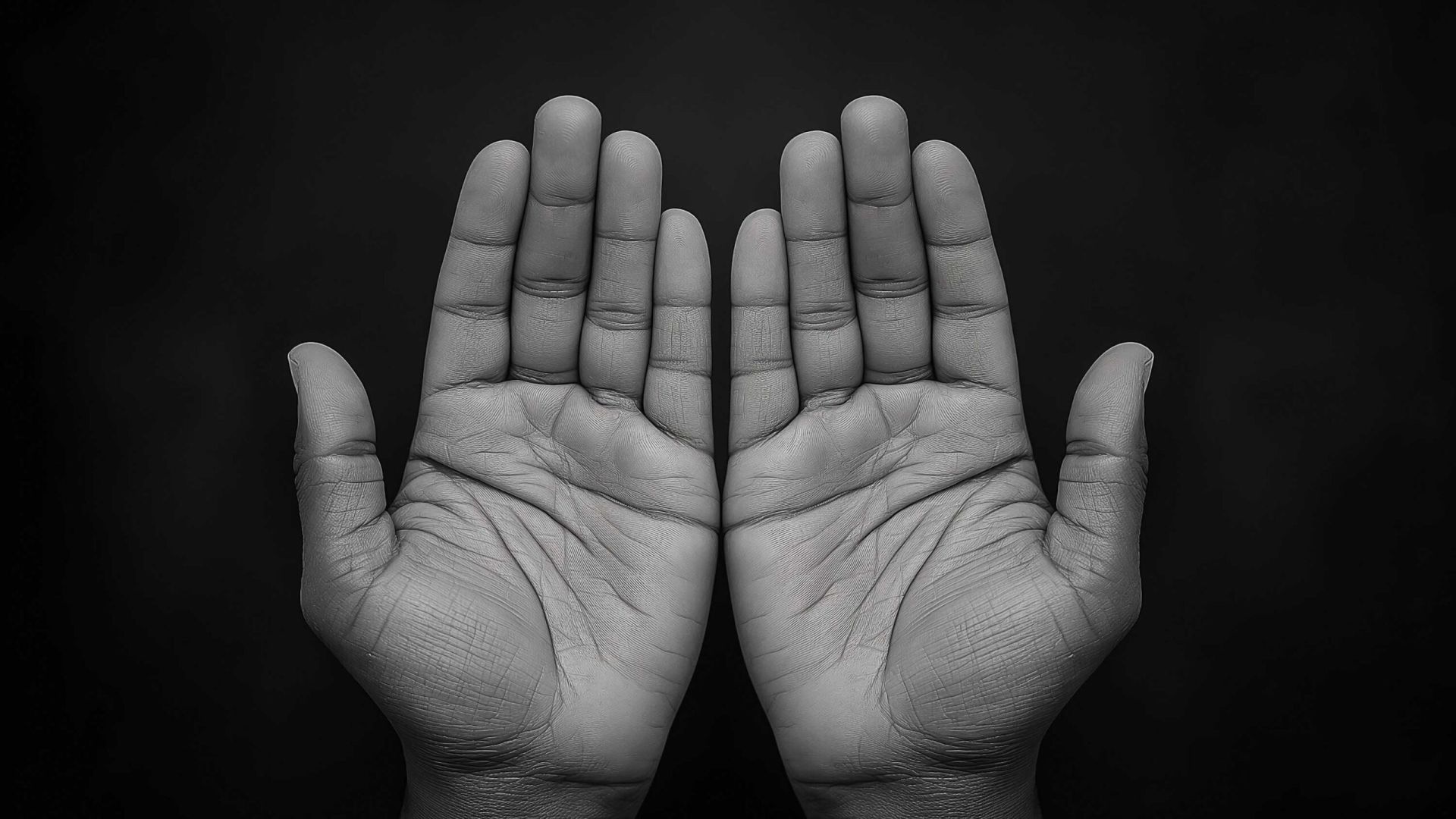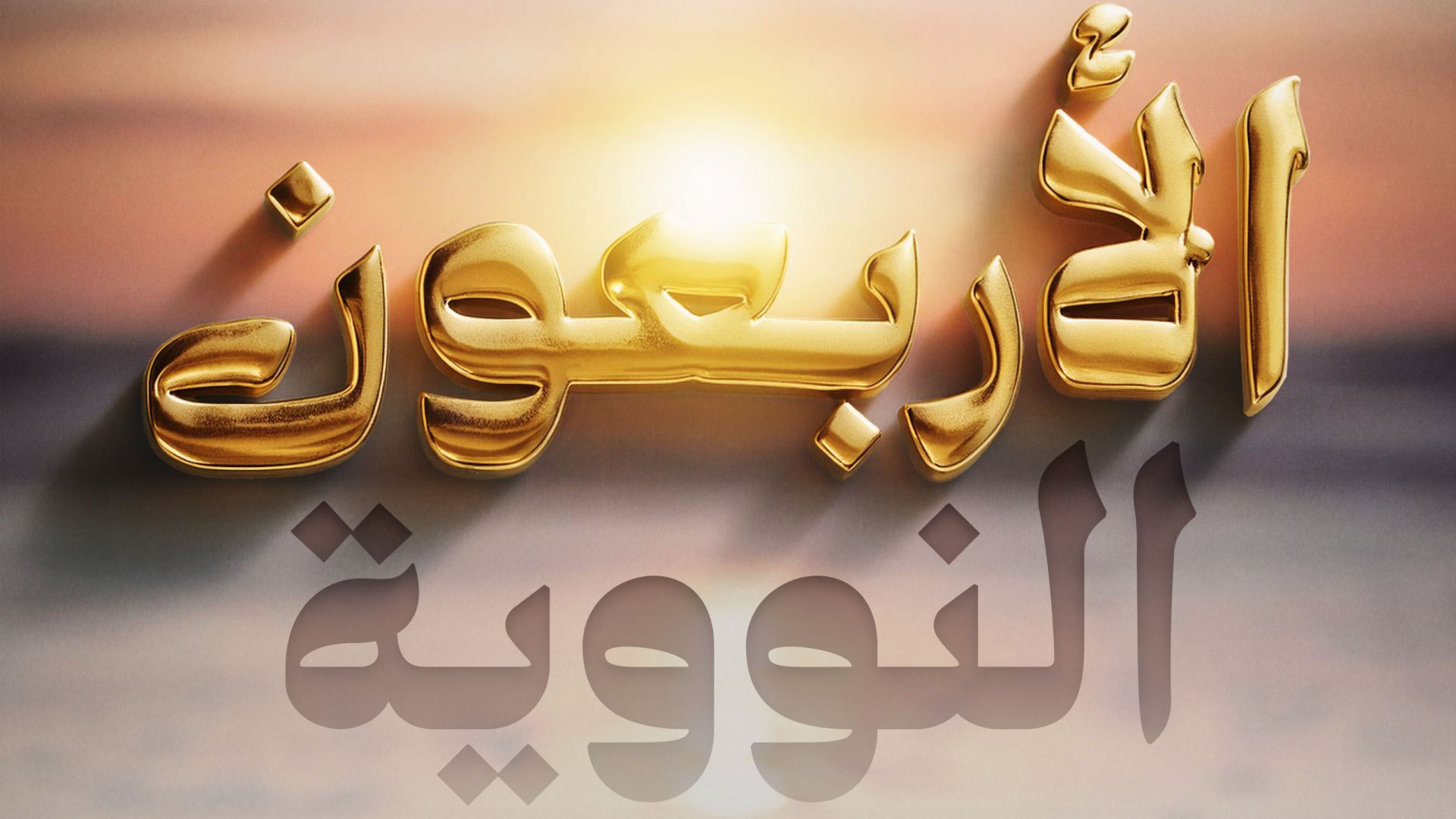On the Placing of Hands in Prayer during Qiyām


To place them on the chest is what is proven in the Sunnah, and all that is contrary to it is either ḍaʿīf or totally baseless.
Below is a translation from ‘Tuhfatul Aḥwadhī bi sharḥ Jāmiʿ al-Tirmidhī’ by al-Mubārakfūrī, on the issue of where to place one’s hands in prayer, (vol. 2, pp. 74+)
[Start of Quote from al-Tirmidhī]
“Chapter: what occurs with regards to placing the right hand upon the left in prayer
‘….and some of them were of the opinion that you place them above the navel, and some below the navel. And all of this was flexible according to them.’
[End of quote from al-Tirmidhī]
His saying, ‘And all of this was flexible according to them (wa kullu dhālik wāsi’un ‘indahum)’
Its clear meaning is that the difference of opinion between them over placing the hands above or below the navel is one of choice and excellence. And know that the aḥādīth and narrations that occur on this subject differ, and due to this there occurred a difference amongst the Imāms, may Allāh have mercy upon them. Here I shall mention the evidence (for each opinion) in 3 sections, along with an explanation of what is for them and against them.
Section One
In explanation of the one who holds to placing the hands below the navel, and they stick to the following aḥādīth:
1) The ḥadīth of Wa’il ibn Hujr (raḍī Allāhu ʿanhū) reported by ibn Abī Shaybah in his ‘Mūsānnaf’ from Wakīʿ from Mūsá ibn ʿUmar from ‘Alqama ibn Wail ibn Hujr from his father who said, ‘I saw the Prophet (ﷺ) placing his right hand over his left below the navel.’
al-Ḥāfiẓ al-Qāsim ibn Qatlūbagā said in his ‘Takhrīj Aḥādīth al-Ikhtiyār Sharḥ al-Mukhtār’ – ‘this sanad is good.’
al-Shaykh Abū at-Tayyib al-Madanī said in ‘Sharḥ al-Tirmidhī’ – ‘This ḥadīth is strong from the point of view of the sanad.’
Shaykh Aabid as-Sindee said in ‘Tawāli al-Anwār’ – ‘it’s narrators are trustworthy.’
I say: even if the isnād of this ḥadīth is good, affirming the words, ‘below the navel’ poses a serious problem.
Ash-Shaykh Muḥammad Hayat as-Sindī said in his book, ‘Fath al-Ghafoor,’ ‘the addition, “below the navel”, is problematic, in fact, it is a mistake arising from neglect. For I checked the authentic text of the ‘Mūsánnaf’ and I saw this ḥadīth in it with this sanad, with this wording but without the additional wording, “below the navel”. After this ḥadīth is mentioned the narration of an-Nakha’i and it’s wording is close to the wording of this ḥadīth, and at its conclusion are the words, “below the navel.” So maybe the sight of the scribe (of the texts of the ‘Mūsánnaf’) slipped from one place to the other and interpolated the wording of the mawqūf narration into the marfu’ narration (as occurs in some of the texts of the ‘Mūsānnaf’)’
And the writer of ‘ad-Durra fī Adh’haar Gash Naqd as-Surra’ said, ‘and as for the ḥadīth of Wail which is depended upon, reported by ibn Abī Shaybah, then there is a lot of discussion on this ḥadīth. For ibn Abī Shaybah reported this ḥadīth, and after it narrated the narration of an-Nakha’i and the wording of the two is close, and at the conclusion of the wording of the narration are the words, “below the navel.” So the texts (of the ‘Mūsánnaf’) differ, and in some of them occurs the mention of the ḥadīth without specifying the place of the hands followed with the narration of an-Nakha’i, and in other texts the ḥadīth is mentioned with the additional wording without the narration of an-Nakha’i following it. So it is possible that the addition arises from negligence on the part of the scribe (of the ‘Mūsánnaf’) by his interpolating the wording of the narration into the ḥadīth. Just as it is possible that the absence of the wording “below the navel” in the earlier texts (of the ‘Mūsánnaf’ arises from neglect of the writer). But the differing in this way shows that the wording of the narration got interpolated into the ḥadīth.’
I say: and the saying of these scholars is supported by the fact that Aḥmad relates the ḥadīth with the same sanad as ibn Abī Shaybah and the addition does not occur in it. So in the ‘Musnad’ of Aḥmad occurs, Wakīʿ narrated to us from Mūsá ibn ʿUmar al-’Inbarī from ‘Alqama ibn Wail al-Hadramee from his father who said, ‘I saw the Messenger of Allāh (ﷺ) placing his right hand upon his left in prayer.’
And al-Dāraqutnī also relates this ḥadīth with the same sanad as ibn Abī Shaybah and there is no mention of the addition in it: al-Husayn ibn Ismāʿīl and Uthmān ibn Ja’far ibn Muḥammad al-Ahwad both related to us from Yusuf ibn Mūsá from Wakīʿ from Mūsá ibn ʿUmar al ’Inbaree from ‘Alqama ibn Wail al-Hadramee from his father who said, ‘I saw the Messenger of Allāh (ﷺ) placing his right hand upon his left in the prayer.’
And this is also supported by the fact that ibn Turkamaanee, the Shaykh of al-Ḥāfiẓ az-Zayla’i mentioned in his ‘al-Jawhar’ two weak ḥadīth to support his madhab where he said, ‘Ibn Hazm said, “it is reported to us from Abū Hurayra who said, ‘place the hand upon the hand below the navel.’ And from Anas who said, ‘three are from the manners of the Prophethood: hastening the iftār, delaying the suḥūr, and placing the right hand upon the left below the navel in the prayer.’”’
And before this two ḥadīth he quotes the narration of Abū Majliz in the ‘Mūsánnaf’ of ibn Abī Shaybah, ‘Ibn Abī Shaybah said in his ‘Mūsánnaf’ from Yazīd ibn Hārūn from al-Ḥajjaaj ibn Hisaan who said I heard Abū Majliz or I asked him, “how do I place (my hands)?” He said, “place the palm of the right hand on the back of the left hand below the navel”’
And he does not quote any other narration from the ‘Mūsánnaf’ of ibn Abī Shaybah, and it is clear that the narration of Wa’il in which the addition, ‘below the navel’ occurs was not in there. And if it was there with this addition then ibn Turkamaanee would have quoted it, for it is inconceivable that he would mention two dāʿīf ḥadīth to support his madhab, and quote the narration of Abū Majliz from the ‘Mūsánnaf’, and not quote the marfu’ ḥadīth of Wa’il with this addition present and it’s ṣaḥīḥ sanad.
And this is also supported by the fact that ash-Shaykh Muḥammad Hayat as-Sindee said in his letter, ‘Fath al-Ghafoor’, ‘that more than one of the Companions of Ḥadīth reported this ḥadīth and there was no mention of the words, “below the navel”, in fact I have not seen or heard any of the people of knowledge mention this ḥadīth with this addition except al-Qāsim.
And this is ibn Abd al-Barr the Ḥāfiẓ of his time saying in ‘al-Tamhīd’, ‘and ath-Thawri and Abū Ḥanīfah said, “below the navel” and this is narrated from ʿAlī and Ibrāhīm an-Nakha’i but it is not authentic from them.’
So if this authentic ḥadīth with this additional wording was in the ‘Mūsánnaf’ he would have mentioned it because he often quotes from the ‘Mūsánnaf’ in this chapter and others.
And this ibn Hajr, the Ḥāfiẓ of his time, saying in his ‘Fath’, ‘and ibn Khuzaimah reported from Wa’il that he placed them upon his chest, and in al-Bazzaar (the wording is) near his chest (‘inda sadrihi), and Aḥmad reports a similar ḥadīth from the ḥadīth of Halb.’
And he says in the ‘Takhreej al-Hidāyah’ that the narration of ʿAlī is dāʿīf, and is contraḍīcted by the ḥadīth of Wail ibn Hujr, “I prayed with the Messenger of Allāh (ﷺ) and he placed his right hand upon his left on his chest.”
And he indicates this in ‘Takhreej Aḥādīth ar-Rāfi’ee.’ So if this addition was present in the ‘Mūsánnaf’ he would have mentioned it, and his books are replete with aḥādīth and narrations.
And this is al-Ṣuyutī, the Ḥāfiẓ of his time, saying in ‘Wadhaa’if al-Yawn wa al-Lail’, ‘he used to place his right hand upon his left and place them firmly on his chest.’
And he mentioned in his ‘Jāmiʿ al-Kabīr’ about eight ḥadīth of Wail from the ‘Mūsánnaf’ and the wording of some of them is, ‘I saw the Prophet (ﷺ) place his right hand upon his left in prayer.’ And this is the wording that the author of ‘Naqd as-Surra’ mentioned with the addition, ‘below the navel’ and if this addition was present then al-Ṣuyutī would have mentioned it.
And this is al-Aini saying in the commentary of Bukhārī, ‘al-Shāfiʿī relied upon the ḥadīth of Wa’il ibn Hujr reported by ibn Khuzaimah in his ‘Ṣaḥīḥ’ who said, “I prayed behind the Messenger of Allāh (ﷺ) and he placed his right hand upon his left on his chest.” And our Hanafī scholars seek support with evidences that are not strong (ghayru wathīqa).’
So if this addition was present in the ‘Mūsánnaf’ he would have mentioned it, and his works are replete with quotes from it.
And this is ibn Ameer al-Hāj, who outdid his shaykh ibn al-Hammaam in research and depth of investigation, saying in ‘Sharḥ al-Maniyyah’, ‘what is established in the Sunnah is to place the right hand upon the left in prayer, and there is no authentic ḥadīth that establishes the place of placing them on the body except the aforementioned ḥadīth of Wa’il.’
So if this ḥadīth were present with this addition, Ibn Ameer al-Haaj would have mentioned it especially since his commentaries are overflowing with quotes from the ‘Mūsánnaf’.” [End of quote from as-Sindee]
I say (in conclusion): the aforementioned ḥadīth of Wail ibn Hujr even though it’s sanad is good, there is a severe problem in affirming the wording, ‘below the navel’ as you have come to know.
2) The ḥadīth of ʿAlī (raḍī Allāhu ʿanhū) reported by Abū Dāwūd, Aḥmad, ibn Abī Shaybah, al-Dāraqutnī, al-Bayḥaqī and Abū Juhayfah that ʿAlī said, ‘the Sunnah is to place the hand upon the hand below the navel.’
I say: it’s isnād contains Abd al-Raḥmān Ishāq al-Wāṣitī, and this ḥadīth revolves around him. And he is dāʿīf and it is not correct to depend upon him.
al-Ḥāfiẓ az-Zayla’i said in ‘Nasb ar-Rāyah’ after mentioning this ḥadīth, ‘ibn Qattaan said, “Abd al-Raḥmān ibn Ishāq, he is ibn al-Harb Abū Shaybah al-Wāṣitī and ibn Ḥanbal and Abū Ḥātim said about him, “rejected in ḥadīth.” And ibn Ma’een said, “he is nothing.” And Bukhārī said, “there is a problem in him.” And al-Bayḥaqī said in ‘al-Ma’rifah’, “it’s isnād is not authentic, And al-Raḥmān ibn Ishāq al-Wāṣitī is alone in reporting it and he is abandoned.” And al-Nawawī said in ‘al-Khulāsa’ and ‘Sharḥ Ṣaḥīḥ Muslim’, “and it is a ḥadīth which is weak by agreement for Abd al-Raḥmān ibn Ishāq is weak by agreement.”’
Shaykh ibn al-Hammām said in ‘at-Tahreer’, ‘when al-Bukhārī says about someone, “there is a problem in him” then his ḥadīth are not depended upon or used for support, or given any consideration.’1
So when you come to know all of this, it becomes clear that this ḥadīth of ʿAlī is not to be depended upon, or used as support or given any consideration. Then it also contraḍīcts the tafsīr of ʿAlī to the saying of Allāh, “wanhar” that he placed his hand upon the center of his left forearm and placed them upon his chest – reported by al-Bayḥaqī, ibn Abī Shaybah, ibn al-Mundhir, ibn Abī Ḥātim, al-Dāraqutnī, Abū al-Shaykh, al-Ḥākim and ibn Mardawiyyah as in ‘ad-Durra al-Manthoor’.2
al-Faadil Mulla al-Haddād said in ‘Haashiyah al-Hidāyah’, ‘so when the ḥadīth of placing the hands below the navel is weak, and contraḍīcts the narration of ʿAlī that he explained His saying, “wanhar”, by placing the right hand upon his left on his chest then it is obligatory to act upon the ḥadīth of Wa’il which al-Nawawī mentioned. Then this (dāʿīf) ḥadīth of ʿAlī is also to be considered abrogated according to the way of the Hanafiyyah. The author of ‘ad-Durra fī Idh’haar Gash Naqd as-Surra’, and he is Hanafī in madhab, said, “Abū Dāwūd reports on the authority of Jarir ad-Dabbi that he said, ‘I saw ʿAlī placing his right hand upon his left wrist above the navel.’ So the principle of our scholars is that when the Companion acts contrary to what he narrates then this indicates the abrogation of what is narrated.’
I say: the isnād of the narration of ʿAlī, I mean the one that Abū Dāwūd relates from Jarir ad-Dabbi is ṣaḥīḥ as you will come to know.
3) The ḥadīth of Abū Hurayra was reported by Abū Dāwūd from Abū Waa’il who said, ‘Abū Hurayra said, hold the hand with the hand below the navel.’
I say: the isnād of this ḥadīth also contains Abd al-Raḥmān ibn Ishāq al-Wāṣitī. So this ḥadīth is also not fit to depend upon, or use as a support or give any consideration to as you have just come to know.
4) The ḥadīth that ibn Hazm mentions in ‘al-Muhalla’ in ta’līq form from Anas with the wording, ‘three are from the manners of the Prophethood: hastening the iftār, delaying the suḥūr, and placing the right hand upon the left below the navel in the prayer.’
I say: I have not come across the sanad of this ḥadīth, and the Hanafī scholars mention it in their books and depend upon it but they do not mention it’s isnād. And if the isnād of something is not known then it is not correct to depend upon it, or use it as support or give it any consideration.
The author of ‘ad-Durra’ said, ‘and as for the ḥadīth of Anas, “from the manners of the Prophethood is placing the right hand upon the left below the navel” about which al-Aini said that it is reported by ibn Hazm, then it’s sanad is not known so as to look into it’s narrators and see if they are acceptable or not. And this ḥadīth has been reported by more than one of the Muhadditheen without the addition, “below the navel”, and an addition (to the wording of a ḥadīth) is only acceptable from known and reliable narrators.’
Ash-Shaykh Hāshim as-Sindee said in his letter, ‘Diraahim as-Surra’, ‘and from them is what al-Zāḥidee mentioned in his ‘Sharḥ al-Qudooree’, and ibn Ameer al-Haaj and ibn Najeem mentioned in ‘al-Bahr ar-Rā’iq’, that it is reported from the Prophet (ﷺ), “three are from the habit of the Messengers: hastening the iftār, delaying the suḥūr, and placing the right hand upon the left below the navel in prayer.” He said: I have not come across the sanad to this ḥadīth except that al-Zāḥidee added that it is reported by ʿAlī ibn Abū Ṭālib (raḍī Allāhu ʿanhū)3 from the Prophet (ﷺ). But ibn Ameer al-Haaj and ibn Najīm said, “that the reporters of ḥadīth do not know the wording, ‘below the navel’ from a marfūʿ or mawqūf narration.”
So this aḥādīth that are depended upon to place the hands below the navel as you have come to know that none of them are correct to use as evidence.
Section 2
In mention of the one who sticks to holding the hands above the navel.
I have not come across a marfu’ ḥadīth that lends evidence to this position. Yes there is the narration of ʿAlī (raḍī Allāhu ʿanhū) which indicates this, as reported by Abū Dāwūd in his ‘Sunan’ from Jarīr ad-Dabbi who said, ‘I saw ʿAlī grasping his left wrist with his right hand above the navel.’
I say: this isnād is ṣaḥīḥ or ḥasan, but it is the action of ʿAlī and is not marfu’. Also the clear meaning of his saying, ‘above the navel’ is a place raised from the navel, i.e. upon the chest or near the chest, as occurs in the ḥadīth of Wa’il ibn Hujr and the ḥadīth of Halb at-Taa’ee and the mursal of Tawwoos, and this three aḥādīth will follow. And this interpretation is supported by his (raḍī Allāhu ʿanhū) tafsīr of His saying, “wanhar” by placing the hands upon the chest in the prayer as has preceded.
Section 3: In mention of the one who holds to placing the hands upon the chest.
These depend on some aḥādīth, from them the ḥadīth of Wa’il ibn Hujr who said, ‘I prayed with the Messenger of Allāh (ﷺ) and he placed his right hand upon his left on his chest in the prayer.’
Reported by ibn Khuzaimah, and this ḥadīth is authentic, authenticated by ibn Khuzaimah as was made clear by ibn Sayyid al-Nās in his ‘Sharḥ al-Tirmidhī.’
ash-Shaykh Muḥammad Qaa’im as-Sindee al-Hanafī acknowledges this in his letter, ‘Fawz al-Kiraam’ that this ḥadīth fulfills the conditions of ibn Khuzaimah where he says, ‘I believe that this ḥadīth fulfills the conditions of ibn Khuzaimah, and this is strongly suggested in the manner of al-Ḥāfiẓ in ‘al-Ittihaaf’, and is obvious from the words of ibn Sayyid al-Nās after he mentioned the ḥadīth of Wa’il ibn Hujr in ‘Sharḥ al-Tirmidhī’ – “and ibn Khuzaimah authenticated it”.’
ibn Ameer al-Haaj, who outdid his shaykh ibn al-Hammaam in research and depth of investigation, said in ‘Sharḥ al-Minniyyah’, ‘What is established in the Sunnah is to place the right hand upon the left in prayer, and there is no authentic ḥadīth that establishes the place of placing them on the body except the aforementioned ḥadīth of Wa’il.’
And this was likewise said by the author of ‘al-Bahr ar-Rā’iq’ as is found in ‘Fath al-Ghafoor’ of Shaykh Hayat as-Sindee.
ash-Shawkanee said in ‘Nail’, ‘and ibn Khuzaimah reported in his ‘Ṣaḥīḥ’ and authenticated it.’
al-Ḥāfiẓ said in ‘Fath al-Bārī’ 4, ‘and he did not mention (i.e. Sahl ibn Sa’d) the place to put them on the body. And ibn Khuzaimah reported from Wa’il that “he placed them upon his chest”, and in al-Bazzaar (the wording is) “near his chest” (‘inda sadrihi), and Aḥmad reports a similar ḥadīth from the ḥadīth of Halb. And in the ‘Zawaa’id al-Musnad’ is the ḥadīth of ʿAlī that he placed his hands below the navel and it’s isnād is dāʿīf.’
And it is clear from the words of al-Ḥāfiẓ that he considered the ḥadīth of Wa’il to be ṣaḥīḥ or ḥasan, because he mentioned here three ḥadīth for the purpose of appointing the place where the hands are to be placed: the ḥadīth of Wa’l, the ḥadīth of Halb and the ḥadīth of ʿAlī. And he declared the ḥadīth of ʿAlī to be dāʿīf, and was silent about the ḥadīth of Wa’il and Halb, and if these were also weak according to him then he would have made that clear…And also al-Ḥāfiẓ made clear in ‘ad-Dirāyah’, after mentioning the ḥadīth of Wa’il reported by ibn Khuzaimah, ‘it is in Muslim without the words, “upon his chest”’.
So it is clear from the words of al-Ḥāfiẓ that this ḥadīth is reported in Muslim, with the same text and sanad, but without mentioning where the hands were to be placed.
In conclusion, the ḥadīth of Wa’il ibn Hujr is ṣaḥīḥ and acceptable to depend upon and to derive evidence that placing the hands on the chest in prayer is totally correct.
And from the aḥādīth that these scholars depend upon is the ḥadīth of Halb at-Taa’ee reported by Imām Aḥmad in his ‘Musnad’ that Yahya ibn Saʿīd narrated to us from Sufyān, from Samaak ibn Qabeesa ibn Halb from his father that, ‘I saw the Messenger of Allāh (ﷺ) turn from his left to right, and place these on his chest, and Yahya al-Yamanee depicted this by placing the right hand upon the left (on the chest) above the level of the elbows.’
And the narrators of this ḥadīth are all trustworthy, and the isnād is linked ….[biographies of the narrators omitted]….and the author of ‘Aal-athar as-Sunan’ acknowledged that it was ḥasan, so to derive evidence from this that the place for the hands in prayer is on the chest is correct.
And from the aḥādīth these scholars depend upon is the ḥadīth of Tawoos reported by Abū Dāwūd in ‘al-Maraaseel’ who said, ‘Abū Tawba narrated to us from al-Haytham i.e. ibn Humaid from Thawr from Sulaiman ibn Mūsá from Tawoos who said, ‘The Messenger of Allāh (ﷺ) placed his right hand upon his left and placed them firmly upon his chest while in prayer.’5
And this ḥadīth is found in some of the texts of Abū Dāwūd. al-Ḥāfiẓ al-Mizzi said in ‘al-Atraaf’ under the letter ‘taa’ from the book ‘al-Marāsīl’, ‘the ḥadīth is reported by Abū Dāwūd in ‘Kitāb al-Marāsīl’ and this was likewise stated by al-Bayḥaqī in ‘al-Ma’rifah’. And the ḥadīth of Tawoos is mursal, because Tawoos is a Tābi’ī (so he could not have seen the Messenger (ﷺ)) and it’s isnād is ḥasan. And the mursal ḥadīth is considered a proof with Abū Hanifah and Mālik and Aḥmad in general. And according to Shaafi’ee, it is a proof when supported by something that occurs via another route that builds upon the first route be it musnad or mursal. And this mursal ḥadīth is supported by the aforementioned ḥadīth of Wa’il and Halb at-Tā’iī. So deriving evidence from these to place the hands upon the chest in prayer is correct.6
: Some of the Hanafiyyah try to claim that the ḥadīth of Wa’il is mudtarib (confused/confounded) because ibn Khuzaimah reports this ḥadīth with the wording ‘upon the chest’ and al-Bazzār with the wording ‘near the chest’ and ibn Abī Shaybah with the wording ‘below the navel’.
I say: it is firmly established in the Uṣul of Ḥadīth that if the ḥadīth simply differs in its wordings then this does not necessitate idtirāb. Rather from its conditions is that the different aspects of the narrations be equivalent in authenticity, so if one of the narrations is found to be stronger then it takes precedence, and if they are equivalent then one can find a reconciliation according to the principles of the Scholars of ḥadīth.7
And in this case, the aspects of difference are not equivalent, for indeed affirming the wording of Ibn Abī Shaybah ‘below the navel’ poses a serious problem as has preceded. And as for the wording of ibn Khuzaimah, ‘upon the chest’, and the wording of al-Bazzār, ‘near the chest’, then the first is stronger and takes precedence over the second, the reason being that the first has support with the ḥadīth of Halb and the mursal of Tawoos, contrary to the second for it has no witnesses…….and even if we were to accept that they were equivalent then reconciliation is possible – that the two narrations were reported with regards to two different prayers. And similar to this difference is the difference of the wording of the aḥādīth to do with raising the hands to the level of the shoulders or to the level of the ears. [i.e. the narrations depict different prayers and it is permissible to do either/or]. So the saying of the Hanafiyyah that the ḥadīth of Wa’il is mudtarib is not to be given any attention.
[the next three pages (83-85) go on to refute the claim of the Hanafiyyah that the ḥadīth of Wa’il is shādh (odd/irregular) and why the narrations here are not shādh and the ḥadīth of ibn Masud ‘then he did not repeat that’ is].8
End of commentary walhumdulillah.
Endnotes:
[1] See also ‘Irwá al-Ghalīl’ (no.353)
[2] al-Albānī discusses this narration of ʿAlī (raḍī Allāhu ʿanhū) in his introduction to the first edition of the new print of ‘Sifah al-al-Ṣalāh’ (pp14-17) and declares it correct to use as a witness.
[3] This is the narration that the author of ‘Albani Unveiled’ quotes as ‘proof’ on pg. 34 of the book, may Allāh guide him!
[4] Fath al-Bārī 2/285 Chapter: Placing the right hand upon the left. The ḥadīth of Sahl ibn Sa’d is: ‘the people were commanded that a person place the right hand on the back of the left hand in the Prayer.’
[5] After mentioning this ḥadīth in ‘Sunan Abū Dāwūd’ 1/194 no.758 there occurs a footnote taken from ‘Awn al-Ma’būd’, “…according to the traditionists (Ahlul Ḥadīth) the tradition is sound. Hence folding hands on the chest in prayer, in their opinion, is the established Sunnah of the Prophet (ﷺ). The traditions regarding the folding of hands above or below the navel are not established as coming from the Prophet (ﷺ).” (1/275-77)
This footnote occurs directly after the quote that the author of ‘Albani Unveiled’ mentions on page 33, why does he not bother to quote this?
[6] The discussion on the ḥadīth of Halb and Tawoos can be found in the aforementioned introduction to ‘Sifah as-Salah’ pg13-14.
[7] See also the discussion of al-Albānī on this principle, and likewise his refutation to the above claim on p16 of the intro to ‘Sifah al-al-Ṣalāh’ (AR.)
[8] So yet again we can see the truth of al-Albānī’s claim that, “To place them on the chest is what is proved in the Sunnah, and all that is contrary to it is either dāʿīf or totally baseless.’ And it is strange that the author of ‘Albani Unveiled’ expects al-Albānī to give every dāʿīf ḥadīth on the issue! This is not the case, and it is not required for al-Albānī to relate the dāʿīf and baseless ḥadīth, rather it is required upon him to relate the authentic aḥādīth on the issue as he does in the main text.

















